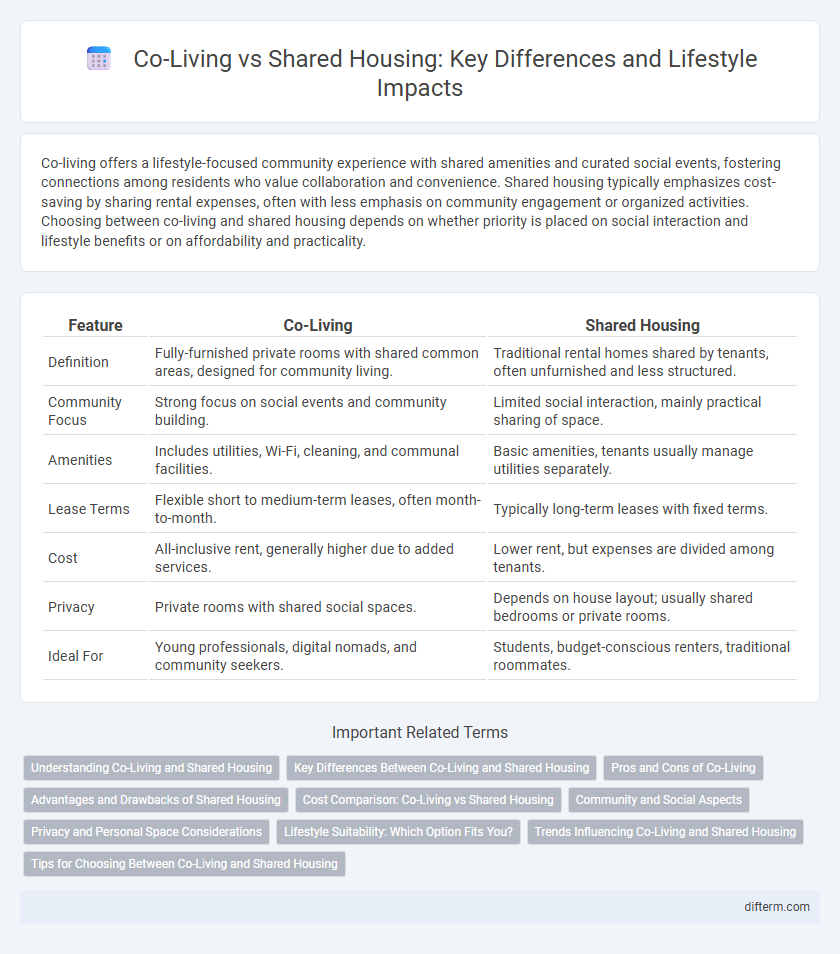Co-living offers a lifestyle-focused community experience with shared amenities and curated social events, fostering connections among residents who value collaboration and convenience. Shared housing typically emphasizes cost-saving by sharing rental expenses, often with less emphasis on community engagement or organized activities. Choosing between co-living and shared housing depends on whether priority is placed on social interaction and lifestyle benefits or on affordability and practicality.
Table of Comparison
| Feature | Co-Living | Shared Housing |
|---|---|---|
| Definition | Fully-furnished private rooms with shared common areas, designed for community living. | Traditional rental homes shared by tenants, often unfurnished and less structured. |
| Community Focus | Strong focus on social events and community building. | Limited social interaction, mainly practical sharing of space. |
| Amenities | Includes utilities, Wi-Fi, cleaning, and communal facilities. | Basic amenities, tenants usually manage utilities separately. |
| Lease Terms | Flexible short to medium-term leases, often month-to-month. | Typically long-term leases with fixed terms. |
| Cost | All-inclusive rent, generally higher due to added services. | Lower rent, but expenses are divided among tenants. |
| Privacy | Private rooms with shared social spaces. | Depends on house layout; usually shared bedrooms or private rooms. |
| Ideal For | Young professionals, digital nomads, and community seekers. | Students, budget-conscious renters, traditional roommates. |
Understanding Co-Living and Shared Housing
Co-living is a lifestyle concept where residents share fully furnished living spaces with communal amenities designed to foster social interaction and collaboration, often including organized events and shared workspaces. Shared housing typically involves renters sharing a traditional home or apartment without the additional community-oriented features, focusing primarily on cost savings and basic shared utilities. Understanding the distinctions reveals co-living's emphasis on community experience and shared values, while shared housing centers on practicality and affordability.
Key Differences Between Co-Living and Shared Housing
Co-living spaces offer fully furnished private rooms with shared common areas, emphasizing community events and curated experiences, while shared housing typically involves renting individual rooms in a conventional home with less structured social interaction. Co-living often includes utilities, housekeeping, and flexible lease terms, contrasting with shared housing's more traditional rental agreements and tenant responsibilities. The community-driven model of co-living appeals to young professionals seeking networking opportunities, whereas shared housing suits individuals prioritizing affordability and privacy.
Pros and Cons of Co-Living
Co-living offers a modern lifestyle with fully furnished spaces, flexible lease terms, and built-in community experiences that foster social connections and networking opportunities. Its major advantages include access to amenities, lower upfront costs, and a strong sense of community, while drawbacks can involve less privacy and potential conflicts due to communal living. Co-living suits individuals seeking convenience and social engagement but may challenge those who prioritize personal space and autonomy.
Advantages and Drawbacks of Shared Housing
Shared housing offers affordability and social interaction by dividing rent and utilities among tenants, making it an attractive option for students and young professionals seeking budget-friendly living arrangements. Privacy challenges and potential conflicts over shared responsibilities can disrupt the living environment, requiring effective communication and clear agreements to maintain harmony. Limited personal space in shared housing may deter individuals valuing solitude, but it fosters community-building opportunities not typically found in more isolated living situations.
Cost Comparison: Co-Living vs Shared Housing
Co-living spaces typically offer all-inclusive rent with utilities, amenities, and maintenance bundled, averaging $800 to $1,200 per month, which can be higher than shared housing costs that range from $500 to $900 monthly but often exclude additional bills. Shared housing allows for more flexible lease terms and lower base rent, though residents may face unpredictable expenses for utilities, internet, and common area upkeep. Evaluating total monthly costs reveals co-living's premium convenience may justify higher prices, while shared housing provides budget-friendly options with potential cost variability.
Community and Social Aspects
Co-living spaces prioritize fostering strong community connections through curated events and shared experiences, creating a cohesive social environment that goes beyond mere housing. Shared housing typically offers more flexible, informal social interactions without structured community-building activities, often leading to varied levels of engagement among residents. In co-living, the emphasis on communal amenities and intentional collaboration promotes deeper relationships and a sense of belonging compared to traditional shared housing setups.
Privacy and Personal Space Considerations
Co-living spaces often provide individual private rooms with personal bathrooms, enhancing privacy compared to shared housing where occupants typically share bedrooms and common bathrooms. Personal space in co-living arrangements is carefully designed to balance community interaction with secluded areas, promoting comfort and security. Shared housing frequently involves more communal living and less private storage, which can impact residents' sense of autonomy and personal boundaries.
Lifestyle Suitability: Which Option Fits You?
Co-living offers a lifestyle designed for social interaction and community engagement, ideal for individuals seeking networking opportunities and shared experiences. Shared housing suits those who prioritize privacy within a communal setting, allowing for flexible living arrangements with roommates or family. Assessing your personal preferences for social interaction, privacy, and budget will help determine the most suitable living option for your lifestyle.
Trends Influencing Co-Living and Shared Housing
Rising urbanization and remote work trends drive the popularity of co-living and shared housing, appealing to young professionals seeking cost-effective, community-focused living. Sustainability concerns and the desire for flexible lease terms further influence preferences towards co-living spaces equipped with shared amenities. Technological advancements in property management apps enhance convenience, making these housing models increasingly attractive in major cities worldwide.
Tips for Choosing Between Co-Living and Shared Housing
Evaluate your lifestyle preferences, such as privacy needs and social interaction levels, to determine whether co-living's community-focused environment or shared housing's flexible arrangements better suit you. Consider budget constraints, lease terms, and included amenities, as co-living often offers all-inclusive packages while shared housing may require individual utility payments. Research location accessibility, house rules, and compatibility with potential housemates to ensure harmony and convenience in your living situation.
Co-Living vs Shared Housing Infographic

 difterm.com
difterm.com